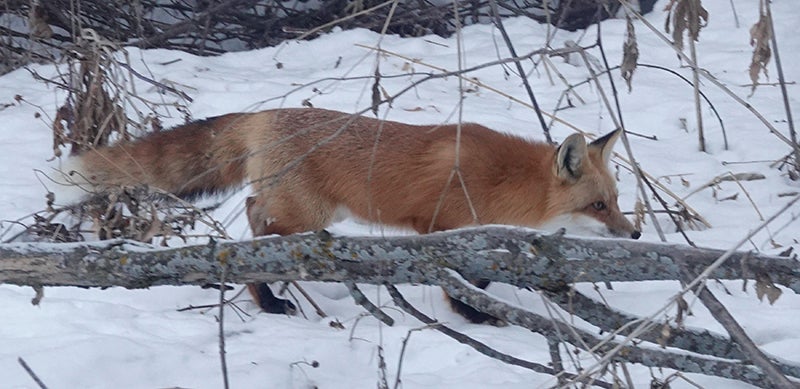Move over, Valentine’s Day; Feb. is National Bird-feeding Month
Published 9:00 am Saturday, February 10, 2018

A Br’er Fox moves furtively through my yard. – Al Batt/Albert Lea Tribune
Al Batt of Hartland is a member of the Albert Lea Audubon Society. Email him at SnoEowl@aol.com.
My neighbor Crandall stops by.
“How are you doing?” I ask.
“Everything is nearly copacetic. I’m still trying to perfect my imperfections and the weather continues to pay me no mind, but I had a great breakfast. My charms were luckied. I bought some new socks. I wear nothing but white socks. That’s because when I was a kid, I had only black socks.“
“Why?” I say.
“It was easier to patch black socks with a black magic marker. We were poor folks.”
“How poor were you?” I ask.
“I wore patches with clothes on them.”
Glimpses of nature
The cardinal is the first at the feeder in the morning and the last at the same feeder when the day’s light has grown dim. A cardinal’s low-light vision must be good. I watched a male cardinal feeding goldfish in a friend’s pond one summer day. The gaping mouths of the fish triggered the cardinal’s instinct to feed. This urge to fill an open mouth transcended species.
I heard the double squawk of a rooster pheasant. “Cow cat,” it crowed. A sign that daylight is lengthening.
By the time I’d staggered outside to answer the call of the world, the wind had picked up. It was a lazy wind. It went through me instead of around me.
Q&A
“I saw a beautiful red fox recently. What does it eat?” It’s an omnivore that eats a wide variety of foods including fruits, berries, grasses, fungi, birds, eggs, small mammals (squirrels, rabbits, voles, rats and mice), crickets, caterpillars, grasshoppers, beetles, crayfish, frogs, lizards, fish, worms, pet food, carrion and garbage. The fox stores extra food under snow, leaves or dirt.
“Why doesn’t a cowbird sing like its foster parents?” Brown-headed cowbirds are brood parasites, laying their eggs in the nests of other bird species. The foster parents hatch the eggs and rear the chicks. Baby cowbirds are raised by birds that don’t look or act like them, sometimes in strange habitats as eggs are laid in the nests of more than 220 species of birds. Somehow, cowbirds learn to recognize other cowbirds by sound and sight. Nestlings are particularly responsive to the cowbird’s chatter call. Some scientists believe this call triggers something in a young cowbird’s brain, like a password that allows a young bird to recognize its own species.
“I’ve heard that cold kills emerald ash borers. Is that true?” U.S. Forest Service and USDA research found that when larvae are subjected to 0°F, 5 percent die; at 10 degrees below zero, 34 percent succumb; at 20 degrees below zero, 79 percent die; and at 30 degrees below zero, 98 percent perish. Larvae are provided insulation from the outer bark and from below the snow line if situated at the base of trees. It might require sustained periods at an ambient temperature before temperatures under the bark drop to that level. Gypsy moth die-offs begin at 20 degrees below zero, but they are insulated by bark, tree and snow, too. Leaf litter and snow provide insulation for many species of insects. Many crop pests die in cold weather. They migrate or are blown here by storm fronts the next year.
“Can birds survive being bitten by a cat?” Great numbers of birds are rescued from the mouths of cats and submitted to wildlife rehabilitation centers for treatment. From the statistics I could locate, the majority of birds bitten by cats die without immediate treatment or antibiotics; approximately 40 percent die from the direct effects of the bites and about 60 percent from infection.
February is National Bird-Feeding Month
According to research done by Ask Your Target Market in 2015, more than 40 percent of U.S. households feed birds. That’s more than 52 million Americans. In 1994, Congressman John Porter of Illinois read a resolution into the Congressional Record. ”I would like to recognize February, one of the most difficult months in the United States for wild birds, as National Bird-Feeding Month.
During this month, individuals are encouraged to provide food, water and shelter to help wild birds survive. This assistance benefits the environment by supplementing wild bird’s natural diet of weed seeds and insects.
In addition, backyard bird feeding is an entertaining, educational and inexpensive pastime enjoyed by children and adults. Bird feeding provides a needed break from today’s frantic lifestyles. Adults enjoy the relaxation and peacefulness afforded by watching birds — nature serves to relieve the stress and can get one’s day going on a tranquil note.”
Thanks for stopping by
“Keep away from people who try to belittle your ambitions. Small people always do that, but the really great makes you feel that you, too, can become great.” — Mark Twain
“The natural world is the refuge of the spirit, remote, static, richer even than human imagination. But we cannot exist in this paradise without the machine that tears it apart. We are killing the thing we love, our Eden, our progenitrix, and sibyl.” — E. O. Wilson
Do good.


